If you’re looking for the best lead generation tools for data enrichment, you’ve probably noticed one big problem: Many legacy providers refresh quarterly, which can leave stale records for months.
You search for a prospect and find a job they left six months ago. Or worse, a made-up email address.
That’s why more sales teams are switching to tools that collect publicly available, up-to-date details from sources such as LinkedIn and company sites, in line with responsible automation practices. No guesswork, no stale contact lists. Just accurate information that helps you reach the right people faster.
You’ll see how each tool sources data, what accuracy you can expect, and the fastest way to turn enriched leads into pipeline.
Understanding data enrichment approaches in 2025
Before choosing a tool, it helps to understand how B2B data enrichment actually works. There are three main approaches, and the differences matter.
- Third-party data providers rely on large static databases. Tools like ZoomInfo, Apollo, and Cognism fall into this group. They offer huge volumes of leads, but the data is often outdated (sometimes refreshed only quarterly or yearly).
- Real-time enrichment tools take a different route. They pull fresh data directly from live sources like LinkedIn, company websites, and social platforms. Tools like PhantomBuster and Clay use this method to deliver up-to-date contact details and insights.
- Hybrid solutions try to strike a balance. They combine static database access with some real-time lookups, offering decent coverage but still limited freshness.
The biggest difference? Most tools give you the same old B2B data your competitors are using. Real-time enrichment helps you build custom, accurate prospect lists that stand out (and convert).
Top data enrichment tools comparison
| Tool | Approach | Key features | Best for | Data freshness | Starting price |
|---|---|---|---|---|---|
| PhantomBuster | Real time data enrichment + automation | Fresh LinkedIn data, 100+ automations, CRM integration | Sales teams needing fresh, targeted data | Real-time from LinkedIn | $56/month |
| ZoomInfo | Third party data provider | Massive B2B database, sales intelligence, predictive analytics | Enterprise sales teams | Updated monthly | Custom pricing ($10k+/year): Contact sales |
| Apollo.io | Lead database + limited automation | All-in-one platform, large lead database | SMB sales teams | Updated monthly | $49/month (free plan available) |
| Clay | Data aggregation + automation | 100+ data sources, waterfall enrichment | Agencies, power users | Mixed (depends on sources) | $134/month (free plan available) |
| Lusha | Third party data provider | Browser extension, phone numbers, EU focus | Individual reps, quick lookups | Variable | $22.45/month (free plan available) |
| Clearbit (now Breeze Intelligence for HubSpot) | Third party data provider | Developer-friendly APIs, company insights | SaaS marketing teams | Updated monthly | Breeze Copilot available with free HubSpot plan; premium features available with paid plans. |
| Cognism | Third party data provider | GDPR compliance focus, EU data | Enterprise teams, EU market | Variable | Custom pricing: Contact sales |
Third party data providers: When size isn’t everything
ZoomInfo
ZoomInfo is a well-known lead generation tools for data enrichment, with one of the largest B2B contact databases on the market.
It offers detailed company insights, job titles, technographic data, and sales intelligence features like intent tracking and predictive scoring.
Key features:
- Massive lead database with in-depth firmographic and technographic data
- Buyer intent signals and predictive scoring
- Strong CRM integrations (Salesforce, HubSpot, Pipedrive, etc.)
- Advanced filtering and analytics for market segmentation
Limitations:
- Custom pricing starts around $10,000/year (see forum thread below)
- Data is often updated monthly
- The same contacts are sold to thousands of other companies
- Long onboarding and sales cycle with complex setup
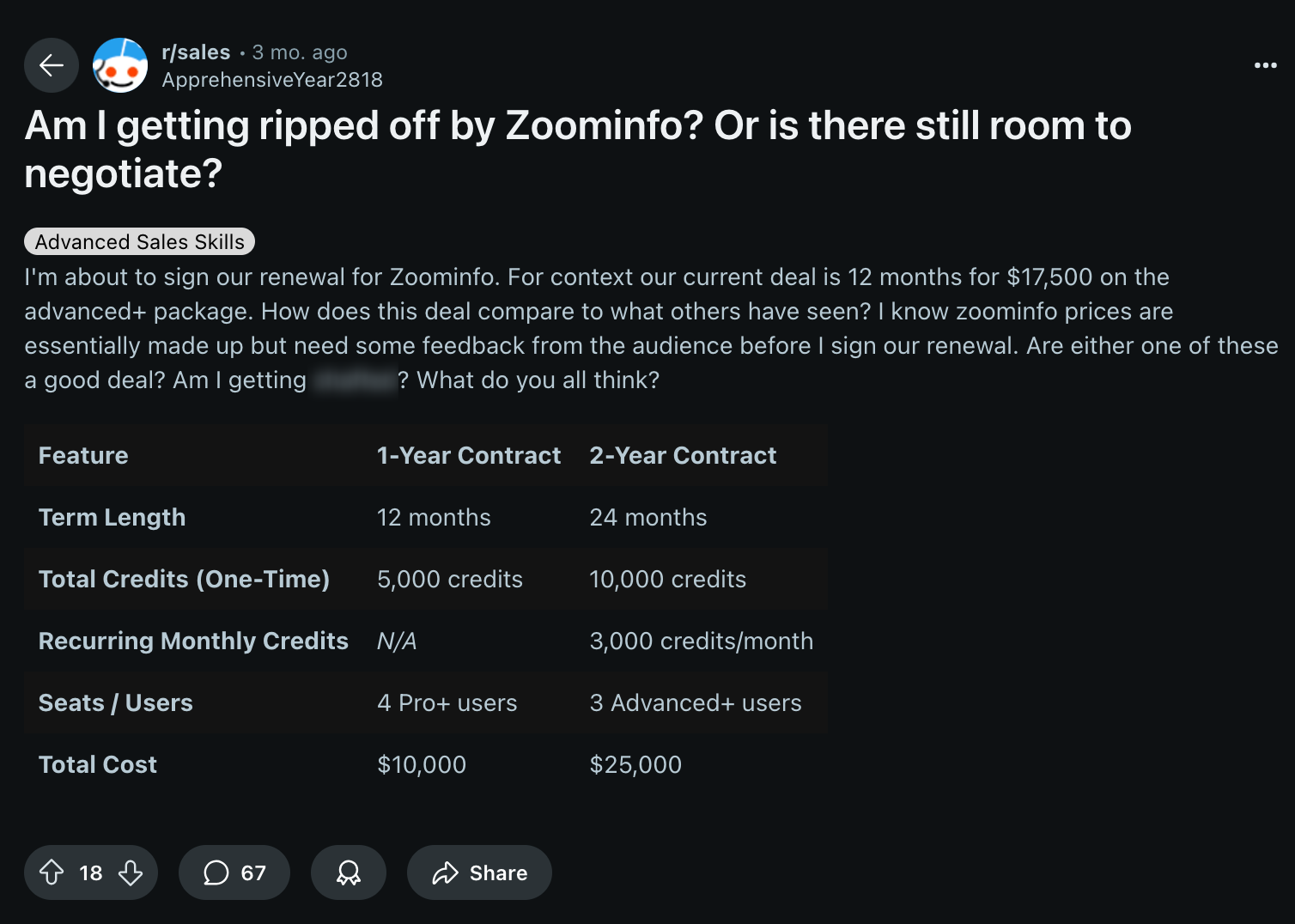
Best for: Enterprise sales and marketing teams with big budgets who want broad market coverage and built-in analytics. Less ideal for teams that need fresh, accurate data for highly targeted outreach (with a tighter budget).
Apollo.io
Apollo is a popular all-in-one sales platform that combines prospecting, enrichment, and outreach in one place.
It’s more affordable than tools like ZoomInfo and offers more accessible pricing for small to mid-sized teams.
Key features:
- Built-in prospecting database, enrichment, and outreach tools
- More affordable than ZoomInfo for SMB marketing teams
- Good CRM and email integrations
- Clean interface and shorter learning curve
- Free plan available with basic functionality
Limitations:
- Data accuracy can be hit or miss, especially for phone numbers
- Fewer automation features than dedicated enrichment tools
- Everyone accesses the same contact database, limiting uniqueness (see Reddit post below)
- Email accuracy varies by region and industry
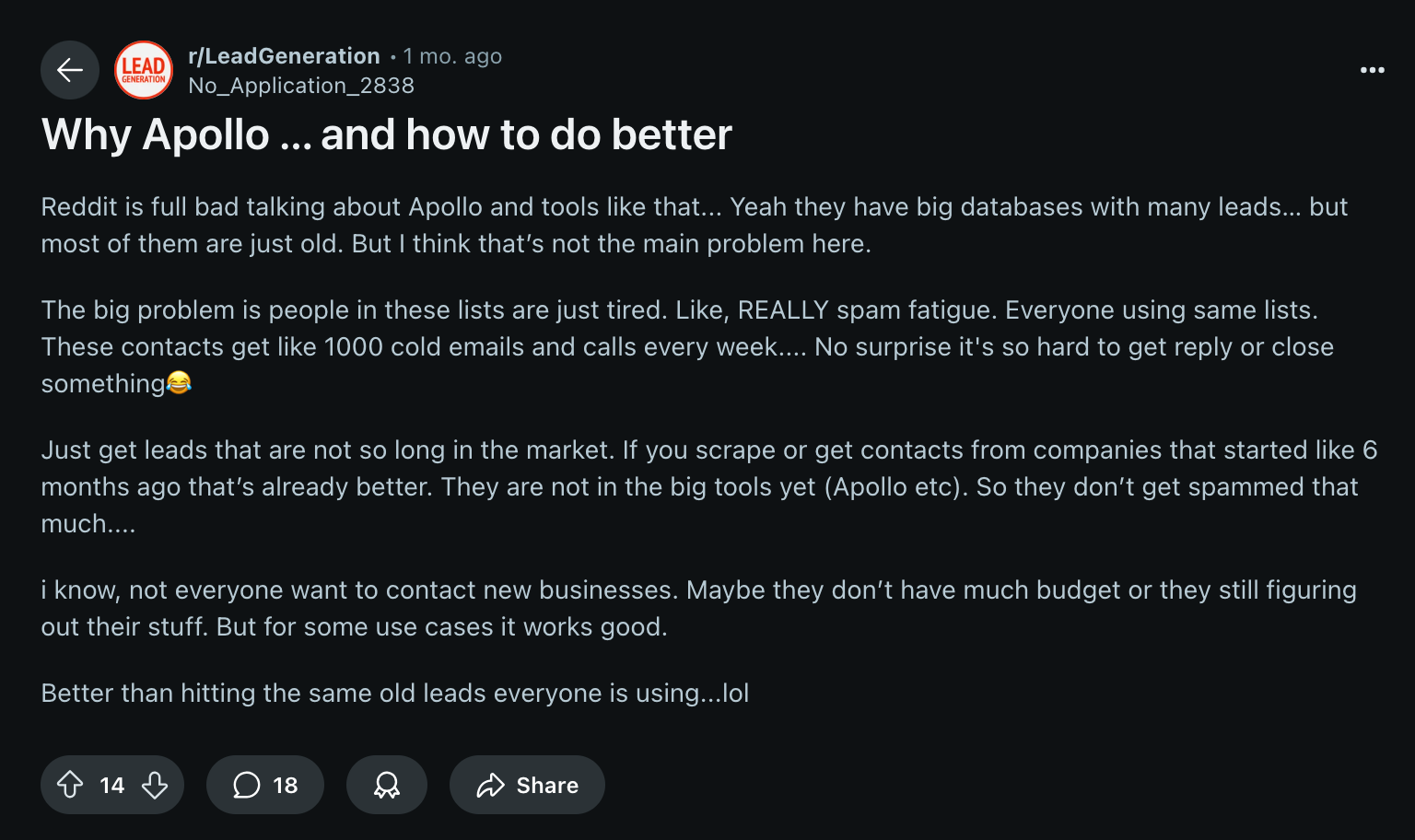
Best for: SMB sales and marketing teams looking for one platform to manage lead generation and outreach, without needing deep automation or hyper-accurate enrichment.
Lusha
Lusha is a quick and lightweight tool for finding contact details, best known for its accuracy in European markets. It works through a browser extension and is popular with individual reps doing manual outreach.
Key features:
- Simple browser extension for fast contact lookups
- Reliable email and phone number data in the EU and North America
- Clear, transparent pricing, including pay-as-you-go options
- Free plan available for light usage
Limitations:
- Limited to basic contact information (email, phone numbers)
- Doesn’t always have accurate data (see review below)
- Limited sales workflows available
- Credit-based pricing can become expensive at scale
- Minimal company data or detailed analytics
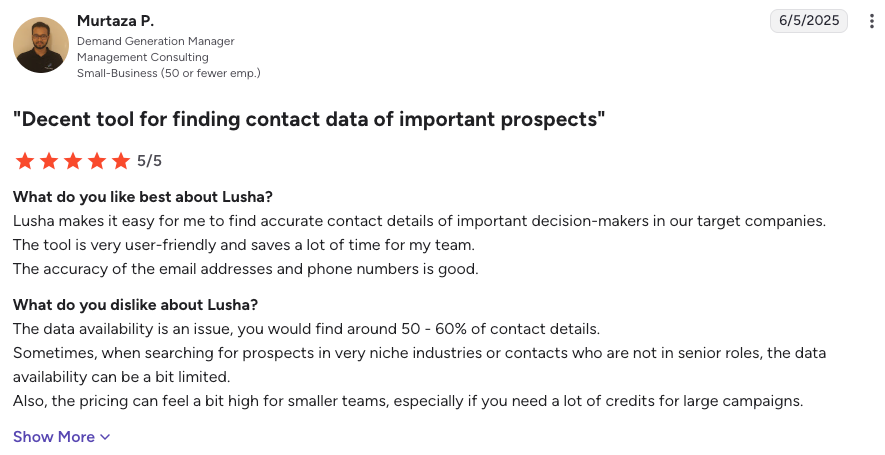
Best for: Individual reps who need accurate contact info fast (especially in Europe) and don’t need full-blown automation or enrichment workflows.
Real-time data enrichment tools: The fresh data advantage
PhantomBuster
PhantomBuster takes a different route. Instead of relying on static lead databases, it pulls fresh contact data from live sources like LinkedIn profiles and company websites, then automates your entire enrichment workflow.

Key features:
- Real-time data enrichment from up-to-date LinkedIn profiles
- 100+ pre-built automations for full prospecting workflows
- Ethically collects public data from the web
- Advanced CRM integrations with automated data sync
- Transparent data sources and collection methods
- Eliminates manual entry with automated enrichment
Why fresh data matters:
- Detects job changes within days, not months
- Captures accurate company and role info in real time
- Surfaces engagement signals like recent posts or activity
- Reveals personalization details missed by static databases
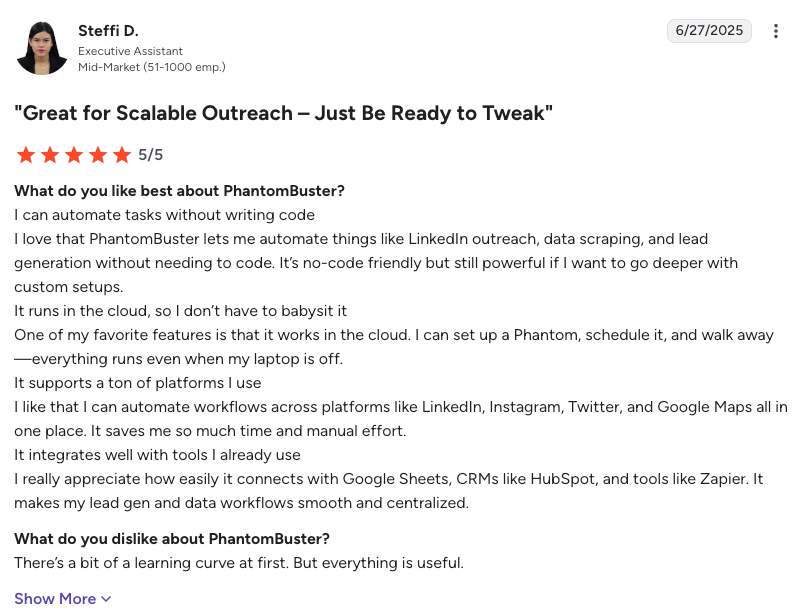
Best for: Sales or marketing teams that need accurate, current data. PhantomBuster is perfect if you want to automate outreach workflows, without relying on generic databases shared by thousands of competitors. Get a 14-day free trial to discover how it works.
Key automations for lead enrichment:
- LinkedIn Profile Scraper: Extract detailed profile information and company data
- LinkedIn Search Export: Build targeted prospect lists for marketing campaigns
- AI LinkedIn Profile Enricher: Add lead scoring and deeper insights
- CRM enrichment: Connect your data with HubSpot, Salesforce, and Pipedrive automatically
Clay
Clay pulls customer data from 100+ third-party sources using a waterfall method. This helps maximize coverage and fill in missing details for each lead.
Key features:
- Combines data from multiple enrichment tools to boost accuracy
- Custom workflow builder for building detailed enrichment steps
- Connects easily to a wide range of tools and platforms
- Great for agencies juggling multiple client campaigns
Limitations:
- Setup can be complex and requires technical skill
- Overkill for teams with simpler prospecting needs
- The interface can feel cluttered for basic use cases
- Credit usage is hard to predict and can spike quickly (see review below)
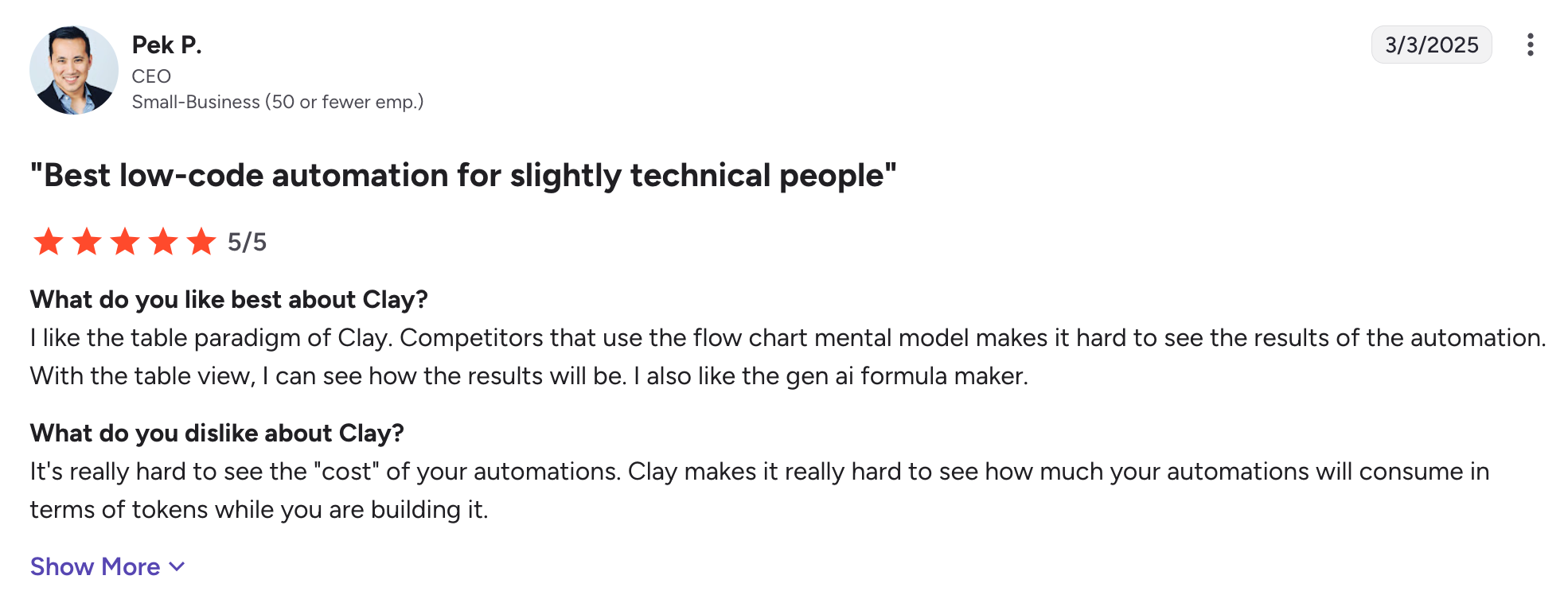
Best for: Agencies, consultants, and technical sales teams running advanced enrichment processes across multiple platforms.
The fresh data advantage: Why real-time beats lead databases
Picture this: Your lead database lists someone as a “Marketing Manager at Company A.” But in reality, they became “CMO at Company B” just last week. If you’re relying on outdated records, your message misses the mark before it even lands.
Impact on sales and marketing efforts:
Higher email deliverability: Real-time data will give you verified emails. Which means you have fewer bounce rates, and you’re one step closer to ideal deliverability rates of 85%—95%.
Better personalization opportunities: With live data, you can tailor outreach based on recent job changes, new company roles, and current activity. For instance, personalized CTAs convert 202% better than generic ones.
Reduced competitor overlap: Static databases are shared with thousands of teams. Real-time enrichment helps you build unique prospect lists that your competitors haven’t seen. This gives you a quieter, more focused field.
Improved response rates: Timely, personalized outreach works. With the right data, you can start more meaningful conversations, and this will drive replies in the long run.
Feature comparison: What matters most
Data accuracy and freshness
Third‑party data providers: Users get 32-69% contact data accuracy due to outdated info. With quarterly or annual updates, records can be months old, causing bounces and wasted outreach.
Real-time data enrichment: Some teams see accuracy jump from 60% to 95%. Real-time tools pull contact details from live sources like LinkedIn, giving you current job titles, roles, and verified emails.
PhantomBuster advantage: PhantomBuster extracts data directly from profiles users keep up to date, so you know you’re reaching the right person, right now.
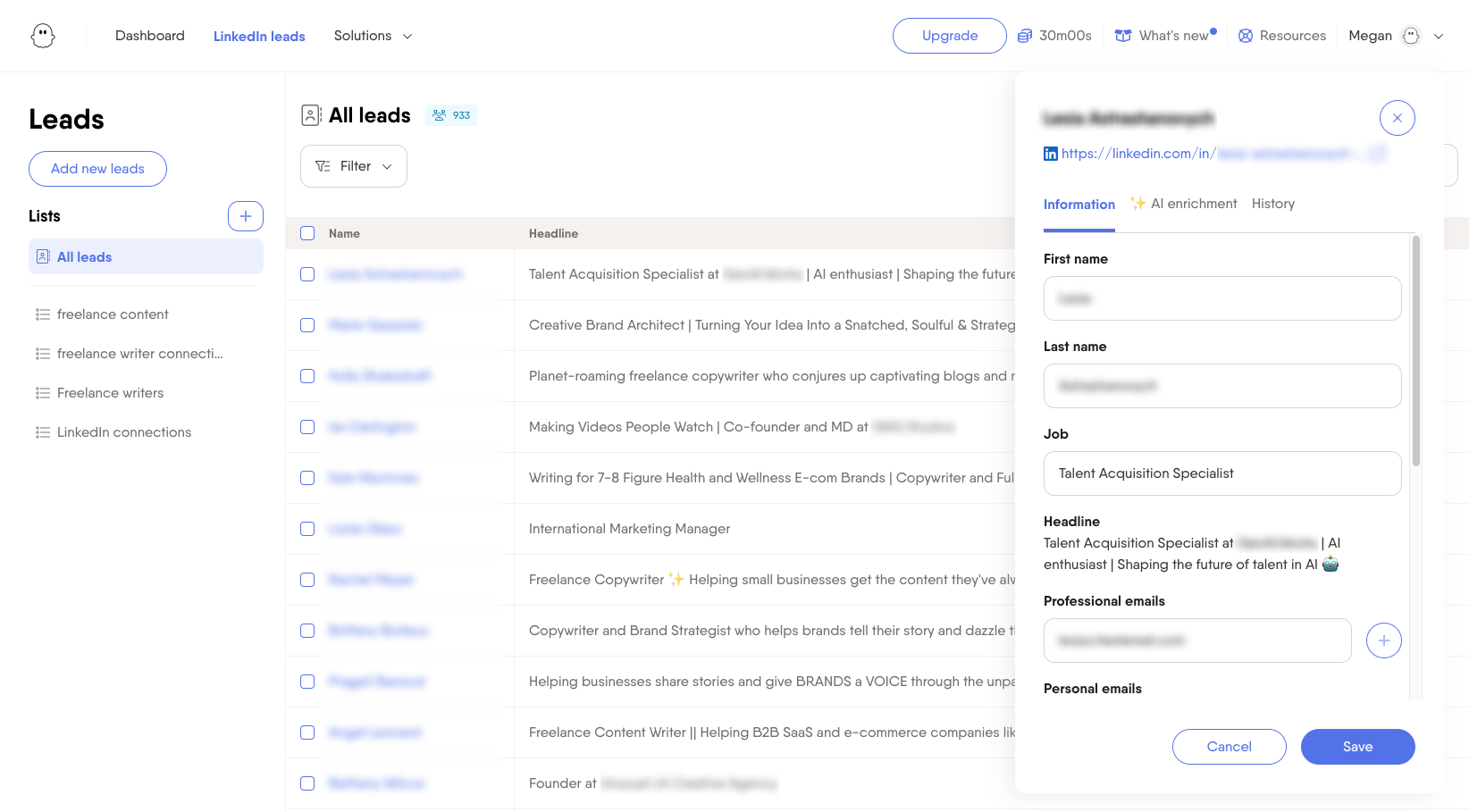
Automation capabilities
Most data enrichment tools: Most platforms focus on simple database lookups or CRM updates. Automation is often minimal, with little flexibility for custom prospecting flows.
PhantomBuster: With 100+ pre-built automations, PhantomBuster handles everything, from finding leads to enriching contact data to triggering outreach campaigns.
Integration depth: PhantomBuster connects with your CRM, finds emails, tracks engagement, monitors social activity, and automates follow-ups—covering the full sales workflow without extra tools.
Compliance and data transparency
Third-party data providers: It’s often hard to verify where their data comes from, making GDPR compliance tricky and putting your outreach at risk.
PhantomBuster: PhantomBuster pulls only publicly available contact details from professional profiles, with clear documentation to support GDPR compliance.
How to choose the right data enrichment tool
For enterprise teams with large budgets
Best data enrichment software: ZoomInfo or Cognism
Why it works: These platforms offer broad lead coverage, deep company insights, and sales intelligence features. While expensive, enterprise teams can justify the cost for large-scale campaigns where data volume matters more than precision.
Best for: Market research, competitive analysis, and high-volume outreach where reach outweighs personalization.
For SMB sales teams
Best data enrichment software: PhantomBuster or Apollo.io
Why it works: These tools deliver fresh, accurate data without breaking the budget. When every lead counts, real-time enrichment and efficient workflows offer a better return than bloated databases.
Best for: Focused prospecting, account-based strategies, and high-conversion campaigns where accuracy drives results.
For agencies and automation-focused teams
Best data enrichment software: PhantomBuster or Clay
Why it works: Agencies need flexible tools that scale across clients. PhantomBuster and Clay support complex workflows and automation, saving time while letting you gain deeper insights.
Best for: Managing multiple client campaigns, advanced workflows, and multichannel outreach.
For individual reps doing manual prospecting
Best data enrichment software: Lusha or Apollo.io free plan
Why it works: Reps need fast access to contact data to streamline sales processes. These tools offer quick lookups and basic enrichment, ideal for day-to-day prospecting.
Best for: One-off searches, lead verification, and building targeted lists by hand.
| User type | Best data enrichment tools | Best for |
|---|---|---|
| Enterprise teams | ZoomInfo, Cognism | Market research, competitive analysis, high-volume outreach |
| SMB sales teams | PhantomBuster, Apollo.io | Targeted sales prospecting, account-based marketing, conversion-focused campaigns |
| Agencies & automation teams | PhantomBuster, Clay | Client campaigns, advanced data ops, multichannel outreach |
| Individual sales reps | Lusha, Apollo.io (free plan) | Manual research, quick lead checks, basic contact enrichment |
Real-world use cases and workflows
Scenario 1: Building targeted prospect lists
Traditional lead database approach:
- Search ZoomInfo lead database using basic filters.
- Export potential customers with potentially inaccurate data.
- Manually verify and clean up outdated customer records.
- Target the same prospects as competitors using the same third-party data.
PhantomBuster approach:
- Use LinkedIn Search Export with precise ICP criteria for your lead generation process.
- Extract current customer data and company details automatically.
- Enrich and verify contact details in real time for accurate data.
- Uncover unique sales intelligence not available in static databases.
Result: Higher data accuracy, stronger personalization, and less competition for prospect attention.
Scenario 2: Account based marketing campaigns
Traditional lead database approach:
- Look up account contact details in a static lead database.
- Access only basic role and contact information in outdated records.
- Miss recent changes or engagement signals critical for timing.
PhantomBuster approach:
- Extract live company employee lists with current job titles.
- Track recent hires for better timing in sales outreach.
- Monitor engagement for warm outreach opportunities.
- Sync updated contacts automatically through CRM integration.
Result: More precise targeting, better timing, and higher engagement across marketing and sales strategies.
Scenario 3: CRM data cleansing and enrichment
Traditional third party data provider approach:
- Upload CRM records in bulk to a data enrichment tool.
- Receive updated customer data with mixed accuracy.
- Manually edit records to correct key contact information.
PhantomBuster approach:
- Sync CRM automatically with fresh LinkedIn customer data.
- Update contacts continuously as roles and details change.
- Maintain data quality with automated workflows, no manual data entry needed.
- Link enriched data to outreach activity for context and insights.
Result: Cleaner records, less manual work, and improved team efficiency.
Implementation best practices
Getting started with data enrichment tools
Step 1: Audit your current data
Before choosing a tool, check for issues in your CRM. Look at bounce rates, outdated job titles, and missing contact info. This helps you spot where bad data is slowing down your sales process.
Step 2: Define what you need
Decide what kind of enrichment matters most to your team:
- Email addresses and phone numbers
- Job title changes for timely outreach
- Company insights for better personalization
- Engagement signals to prioritize warm leads
Step 3: Decide between automation vs. databases
Think about your budget and how your team sells. If you rely on large-scale, low-touch campaigns, then a lead database might be enough. But if your strategy depends on accuracy and timing, then real-time enrichment tools give you better results and actionable insights.
Step 4: Set up automated workflows
Set up recurring updates and trigger-based workflows. This keeps your data clean without manual work and ensures your team always has up-to-date customer records.
Maximizing ROI from enrichment tools
Step 1: Choose quality over quantity
Five hundred accurate leads will outperform 5,000 outdated ones. Focus on current, verified data to protect your sender reputation and save your team time.
Step 2: Integrate with your sales stack
Connect your enrichment tool to your CRM, email platform, and sales engagement tools. This keeps data flowing automatically and reduces manual work.
Step 3: Track the right metrics
Forget database size. Watch deliverability, reply rates, and meetings booked. These show whether your enriched data is actually driving results.
Step 4: Equip your team
Make sure everyone understands your data enrichment process. Train sales and marketing to personalize better and time their outreach based on live data points.
FAQ
What’s the difference between database and extraction tools?
Database tools like ZoomInfo give you access to large lead lists that are updated every few months.
Extraction tools like PhantomBuster pull live data from sources like LinkedIn in real time. The trade-off is that while databases give you volume, extraction gives you freshness and accuracy.
How accurate are data enrichment tools?
Databases usually hit 32—69% accuracy due to slow update cycles. The longer the time since a database update, the more that gap matters. Real-time tools like PhantomBuster can hit 95% accuracy by pulling up-to-date contact info directly from live profiles.
Which tools integrate best with CRMs?
Most modern tools connect with platforms like Salesforce, HubSpot, and Pipedrive.
PhantomBuster automates data enrichment syncing with popular CRMs, whereas database tools tend to offer basic API integrations or manual uploads.
Choose based on whether you want a one-time import or ongoing sync for real-time insights.
Are data enrichment tools GDPR compliant?
It depends on how they source their data. Many databases don’t clearly show where data comes from.
PhantomBuster only uses publicly available info from professional profiles and clearly documents its data collection, helping teams stay compliant.
How much should I budget for data enrichment?
Paid plans range widely—from $29/month for a basic data enrichment solution like Lusha, to around $830+/month for tools like ZoomInfo.
PhantomBuster starts at $56/month and tends to offer a better cost per accurate lead. Some tools also offer free plans for small teams.
Can I use multiple enrichment tools together?
Yes. Many marketing and sales teams combine tools. They might use databases to find a broad set of leads, then real-time enrichment tools like PhantomBuster to get fresh, accurate info on top prospects. This hybrid approach improves both scale and quality.
How often should I enrich my lead data?
With traditional databases, updates happen quarterly. Real-time tools let you refresh data continuously. Best practice: set up automatic enrichment daily or weekly for active leads, and monthly for the rest of your CRM.
